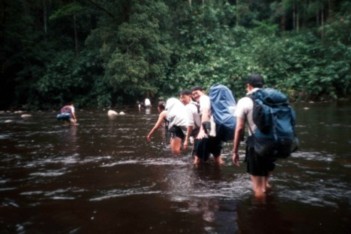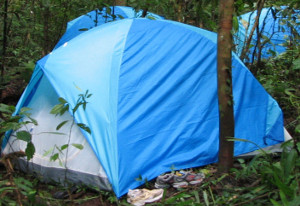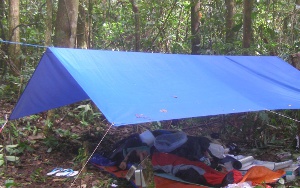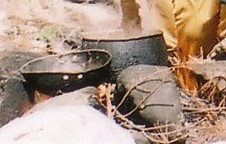Steeper section of a typical forest trail in Malaysia. |
Most treks in South-East Asia involve walking in tropical rainforests and crossing rivers up to waist deep. Trails in the rainforest are often small and covered with leaves and roots with occasional fallen trees and logs cutting across the path. For treks with higher traffic, it is common to see large steps at steeper slopes caused by soil erosion. Trekking poles may not be that useful as the trails are sometimes narrow with trees lining the side. You may also need to use your hands to get up steep slopes by holding or pulling on the roots or tree trunks and the poles will be a hindrance in this situation. Use only one pole to aid in your trekking on the gentler sections if preferred.
Many of the treks are to the rivers, hills and mountains and the duration may span from over an hour to several days. For long distance treks especially on mountains, it is important to conserve energy and some basic foot technique will help you complete the trek. Proper technique will also reduce the risk of knees and ankle sores and injuries.
Uphill treks
Always try to plant your whole foot on the higher step instead of just the ball of your foot to get up. This way, you will make use of your larger thigh muscles instead of the smaller calf muscles to lift your weight. This is particularly useful for long ascent as the bigger muscles offer more endurance.
Downhill treks
Do not be tempted to grab hold of the trunks and saplings without looking as you descend with speed. Many plants and shrubs are protected by spikes.
During the descent, always try to lower your body down with your front leg slightly bent as it touches the lower step.
Avoid balancing on exposed roots with the ball of your descending foot before taking the next step. They may be slippery. Always ensure you have a firm footing on the step before taking the next step and have your hand ready to grab onto the saplings or thin trunks that line the side of the trail in case you slip.
Crossing logs
Do not waste energy by stepping onto logs. For small logs and obstacles crossing your path, always step over the obstacle instead of on the obstacle. For large fallen logs at about the waist level, try sitting on it and swinging your legs over it. Another technique is to place both hands on the log, put one foot on the log and swing the other leg under the leg on the log as illustrated below.

|

|

|
| Step 1: Face the log, put both hands on the log and put your first leg on it with the inner foot on the log | Step 2: Bring your second leg under first leg | Step 3: Swing the second leg over the log and release the first leg from the log. |
River crossing
At river crossings where both your feet have to be in the water, always try to put place feet between larger stones and rocks in the water instead of trying to balance on them. Rock surfaces under water are usually slippery and almost impossible to keep your balance on it.

River crossing in Malaysia forest trek. |


